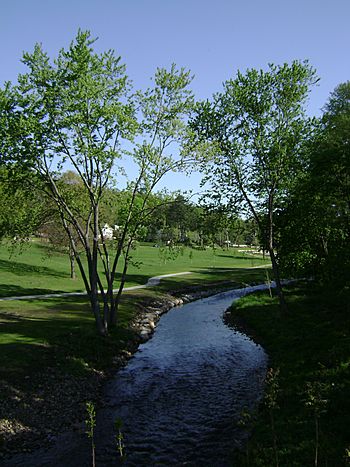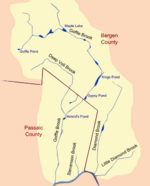Goffle Brook facts for kids
Quick facts for kids Goffle Brook |
|
|---|---|

Goffle Brook viewed from Diamond Bridge Ave in Hawthorne
|
|

Goffle Brook and Diamond Brook Watershed
|
|
| Other name(s) | Wagaraw Brook |
| Country | United States |
| State | New Jersey |
| Counties | Passaic, Bergen |
| Physical characteristics | |
| Main source | Goffle Pond Wyckoff, Bergen County, New Jersey, United States 404 ft (123 m) 40°59′29.25″N 74°10′58″W / 40.9914583°N 74.18278°W |
| River mouth | Passaic River Hawthorne, Passaic County, New Jersey, United States 36 ft (11 m) 40°56′14.21″N 74°9′42.65″W / 40.9372806°N 74.1618472°W |
| Length | 7 mi (11 km) |
| Basin features | |
| Tributaries |
|
Goffle Brook is a small river, also called a tributary, that flows into the Passaic River. It runs south through parts of Passaic County and Bergen County in New Jersey. This brook helps drain the eastern side of the First Watchung Mountain.
As you follow the brook from where it meets the Passaic River, you'll pass through several towns. These include Hawthorne, Ridgewood, Midland Park, and Wyckoff.
Contents
A Look Back: History of Goffle Brook
People have lived near Goffle Brook for hundreds of years. We know this because many old Lenape camp sites have been found along its banks. Two of these camps were close to where the brook meets the Passaic River. Two more were about one and a half miles upstream. Another camp, still remembered by local people, was where Deep Voll Brook joins Goffle Brook.
Goffle Brook During the American Revolution
During the American Revolutionary War, important military leaders used the brook for their troops. In 1780, General Lafayette stationed his soldiers along the brook's banks. Major Lee's Virginia light horse troop stayed on the east bank. Lafayette's light infantry corps was on the sides of the First Watchung Mountain to the west. General Lafayette's main office was on the western bank of the brook. This spot is now part of Goffle Brook Park in Hawthorne.
How Goffle Brook Helped Early Settlers
Before the 1900s, the way the brook flowed helped power many mills. These mills included sawmills (for cutting wood), grain mills, and grist mills (for grinding grain). The brook was likely very important for the first people who settled and farmed in the northern Passaic River valley. It provided both water and energy.
Goffle Brook in Art and Recreation
Goffle Brook has also inspired artists. New Jersey writer William Carlos Williams wrote about the brook in his 1949 poem Spring is Here Again, Sir. The poem starts with a line about the brook "blossoming in the manner of antiquity."
Today, Goffle Brook is a main feature of Goffle Brook Park and Kings Pond Park. These parks offer fun activities like fishing and ice skating for people living nearby.
Goffle Brook and the NYS&W Railway
The New York, Susquehanna & Western Railway runs next to Goffle Brook for most of its journey. This railway goes through Hawthorne, Ridgewood, Midland Park, and Wyckoff. The train tracks generally follow the middle of the Goffle Brook area. The railroad only crosses the brook twice: once in Ridgewood and again in Midland Park.
Exploring Goffle Brook's Tributaries
A tributary is a smaller stream or river that flows into a larger one. As you travel north along Goffle Brook from its mouth, you'll find several of these smaller streams joining it.
Janes Brook and Deep Voll Brook
The first tributary you'll see is Janes Brook in Hawthorne. Much of this small stream, found in the southern part of Goffle Brook Park, was turned into an underground sewer. However, a tiny part of it still flows above ground before it empties into Goffle Brook.
The second tributary is Deep Voll Brook, also called Deep Brook. This stream joins Goffle Brook just north of Goffle Hill Road. This is at the northern end of Goffle Brook Park in Hawthorne. Deep Voll Brook is the most important tributary of Goffle Brook. It drains a large area of the northeastern First Watchung Mountain in Hawthorne and Wyckoff.
Other Smaller Streams
Beyond Deep Voll Brook, two smaller streams join Goffle Brook close to each other. These two tributaries don't seem to have official names. After these, another tiny tributary drains a small swamp. This swamp is at the beginning of Kings Pond, which is a lake made by people in southwest Ridgewood.
The Branches of Goffle Brook
Further north, past the Kings Pond tributary, Goffle Brook splits into two parts: a western branch and an eastern branch. This split happens at Maple Lake. Maple Lake used to be a swimming hole made by people, but it was drained in the late 1980s.
The eastern branch is shorter and less important. It goes a short distance through Wyckoff before ending near the southern edge of Waldwick. The western branch is much longer. It almost cuts through the middle of Wyckoff. This branch ends west of Russell Ave at Goffle Pond, which is where Goffle Brook begins.
Dams Along Goffle Brook
There are seven dams along Goffle Brook today. In the past, there were ten dams.
- In Hawthorne, a former dam at the southern end of Goffle Brook Park once created Mill Pond.
- Another dam just south of Goffle Hill Road now forms Arnold's Pond, which people often call the Duck Pond.
- In Ridgewood, a dam north of Rock Road creates Gypsy Pond.
- A larger dam a little further upstream holds back Kings Pond.
- The fourth and fifth dams are just west of where Goffle Road crosses the brook in Midland Park.
- A dam that was destroyed during a storm used to be just upstream from the Sicomac Avenue bridge. This dam created Morrow Pond, which was a swimming hole in Midland Park.
- North of Canterbury Lane in Wyckoff, a dam used to exist. It held back Maple Lake, which is now a wetland area.
- Two more dams create large lakes on the north and south sides of Wyckoff Ave, also in Wyckoff.

